
|   |

|   |
 e-mail: ukb7@rediffmail.com Seven Nymphs from Manipur Photos courtesy: Chorus Repertory January 21, 2019 Silhouetted in the rear horizon, the angelic nymphs are painted still, in white gossamer chiffon. Then, in ever slow steps, they descend as though from heaven to the soiled earth in front stage, beginning their journey through the muddle of anguish and sorrow, the quivers of joy and ecstasy. Edging along and deciphering on their journey many wayward challenges through their rituals and traditions, they carry the seeds of human identity and culture -- inherited from the very distant ancestors - and move through the past, present and future, negotiating peace of sky, peace of earth, peace of water, peace of trees and peace of man. The nymphs are flying towards 22nd century . . .
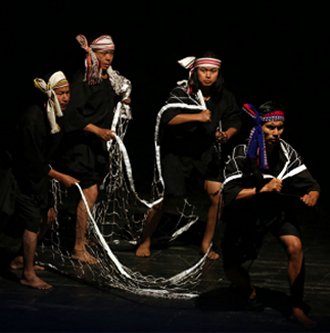
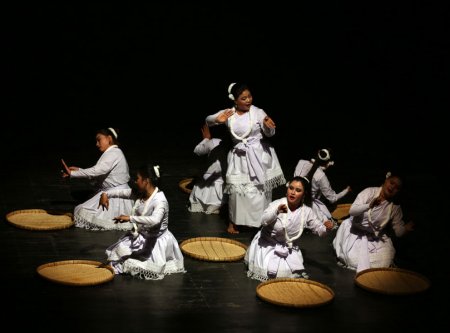
Lairembigee Eshe (Song of the Nymphs), the play presented on January 11 by Chorus Repertory from Imphal, Manipur - as the grand finale of the 4th National Theatre Festival 2019, organised by 'Minerva Natya Sanskriti Charcha Kendra' was a monumental saga on human conditions, told in the allegorical language of mystery and magic. With script, music, design and direction by the redoubtable thespian Ratan Thiyam, the play that had its premiere in Kolkata, could well be considered a sequel to Thiyam's well-known earlier oeuvre, Hey Nungeshibi Prithivi (My Earth, My Love) and Chinglon Mapam Tampak Ama (Nine Hills, One Valley) and completed a “trilogy” that caught the connoisseurs' eye on Manipur's mythic past, anguished presence and the uncertain future. The present play was on a wonderful sure footing in terms of its conceptualisation and choreography, its visual effects and illumined zoning, its orchestration of physical acting and the mystical ritual dances of the Meiteis in their Lai Haraoba tradition from the pre-Vaishnavite era. To a very large extent, it was almost a dance-drama, interlaced with daily practices or annual happenings that dwelt upon shearing, reaping and harvesting. The local and indigenous myths were brilliantly crafted in the play for both verbal and non-verbal expression and interpretation. 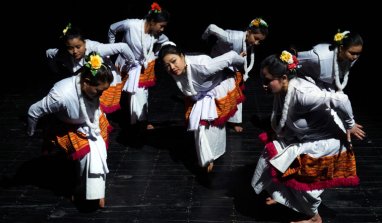
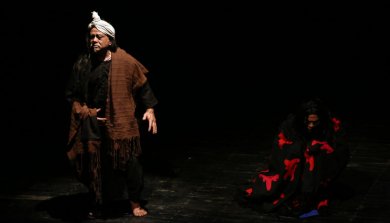
The play visualised many memorable vignettes: the fairy sisters lamenting with prayerful tears to their ancestors; their enjoying gleeful games of daily chores; the tussle between hunters and their prey: the merry flock of birds winging their way out of the foreboding catchers' nets; the remorseful king - afflicted with multiple ailments --- seeking redress from the queen of the nymphs; the rites of passage danced in delightful Meitei movements in wholly ritual stances; and the nymphs voicing their coaxing and cajoling concerns. The transition from antiquity to modernity was striking: the fairies living in symbolic 'boxes' of entrapment and coming out to address the spectators in today's English lingo as though breaking out of their enforced exile! In the last scene, when the fairies and their umbrella-bearers mounted the elevated slopes - to the tune of haunting Pena music - it was an unforgettable visual experience. Kudos to the Chorus Theatre's ever-young dramatis personae for gifting the viewers a memorable evening! 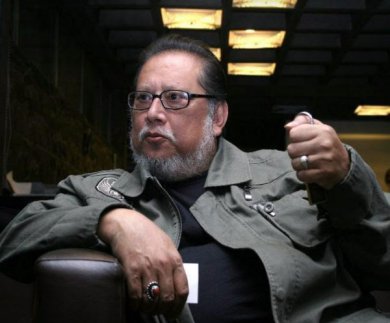 Extracts from an interview with the director: Why have you chosen seven nymphs? Seven is not a random number for the people of Manipur, particularly the Meiteis. Number 'seven' plays an important role in the culture and traditions of the Meiteis. There are seven days of the week and seven colours of the rainbow. Seven celestial nymphs of the creation myth were brought forth by Leimaren Shidabi (immortal mother) or the mother goddess. And there were seven tribes that amalgamated to form the Meiteis. The tribes became salais (clans) of the larger group of the Meiteis. In the play, the nymphs representing time and space, are in a new avatar as witnesses of the changes in nature, environment and human condition brought by development through the ages. How have you depicted Manipuri society in your play? I have selected Manipuri society as a microcosm of the 'global village' and tried to bridge the gaps in our understanding. My play tries to right the misconstrued concepts of freedom and equality, beauty and truth, love and harmony. Culture and traditions of the Meiteis derived from various forms of connectivity of their ancestors to the elements - incidentally, seven in number, namely, earth, sun, moon, sky, forest, water and creatures -- are manifested in movement, sound and rhythm. I have tried to reflect them in the play. 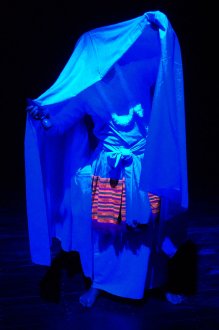 Could you please explain the cadenza of Manipuri language used in the play? I have used archaic Manipuri language in the play in abundance. But I have tried to handle the language in such a manner that makes it easy for the audience to follow the dialogues in archaic Manipuri. One interesting feat which I have tried to achieve is the way the language in the dialogues gradually shifted from the archaic Manipuri to the modern, as the scenes progress from antiquity to present. Finally, how would you sum up your highly stylized directorial approach to your plays? My theatre, my piece of work and expression is a response to my existence in everyday life. It contains my tradition, inspiration of myth and legend and even the lovely and tastiest cuisine that I consume! Eagerness of entering unknown areas, new and untried methods, and unfamiliar devices helps me in my experimentation. In each new piece of work - I feel that I am wrestling with techniques to find out the exact vehicle of expression for the thematic content. I am a dreamer and my dream takes me forward in my journey. I feel as if I am coming back from a pilgrimage after each and every production I have completed. A good theatre carries the ability to leave behind an imprint to the intellect and senses of the spectators. It is a vehicle of expression for sharing thoughts to a wide ambience across intellectual, cultural or linguistic boundaries. I am just trying...  Dr. Utpal K Banerjee is a scholar-commentator on performing arts over last four decades. He has authored 23 books on Indian art and culture, and 10 on Tagore studies. He served IGNCA as National Project Director, was a Tagore Research Scholar and is recipient of Padma Shri. Post your comments Please provide your name and email id when you use the Anonymous profile in the blog to post a comment. All appropriate comments posted with name & email id in the blog will also be featured in the site. |